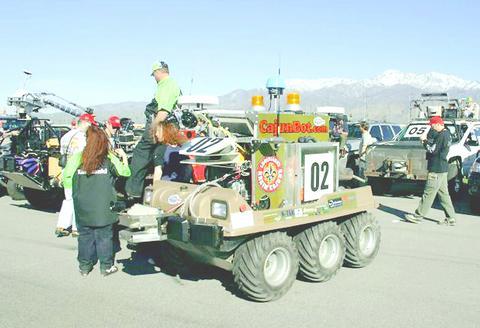Fifteen robot vehicles took off across the Mojave Desert starting at dawn on Saturday, dodging boulders and tortoises in search of a place in scientific history and US$1 million in Pentagon cash.
The 228km race over some of the most forbidding terrain on the planet was sponsored by the Defense Advanced Research Projects Agency, or DARPA, the Pentagon's own skunk works that spawned the Internet, the Predator drone and the stealth fighter.
The top qualifier, Red Team Sandstorm, sped out of the starting line at the SlashX ranch, south of Barstow, to the cheers of several thousand spectators, and quickly reached speeds of 32km an hour. Other vehicles followed at five-minute intervals.

PHOTO: EPA
Within an hour, however, the course began to take its toll. Sandstorm, based on an Army surplus Humvee and put together at the robotics laboratory at Carnegie Mellon University, was the first casualty, as it veered off course down an embankment. When Sandstorm returned to the course, it burned out a mechanical part.
Shortly afterward, David, the entry from Ensco Incorporated in Falls Church, Virginia, struck a bush and rolled over. The Acura MDX entry from Palos Verdes High School in California failed to make a turn at the start, ran directly into a barrier and was out of the race.
Less than four hours after the race began, all vehicles had either crashed or been demobilized. The most successful robot belonged to the team SciAutomics, based in Thousand Oaks, California. The team was sponsored by Elbit Systems, an Israeli manufacturer of off-road vehicles. The SciAutomics vehicle managed to go 12.8km.
No one won the cash prize, which required finishing the course within 10 hours.
The competition, announced a little over a year ago, gave birth to some of the strangest contraptions ever built: computer-laden mechanical monstrosities that began life as golf carts, dune buggies, hybrids, luxury sports utility vehicles, all-terrain vehicles, a motorcycle and a 16-ton military truck.
They went by the names Terrahawk and TerraMax, Ghost Rider and Doom Buggy, Golem and Ladibug, Cliff and Bob. The rules required the vehicles to traverse the difficult course without human intervention. These were meant to be true autonomous vehicles, not remotely piloted machines or drive-by-wire craft like the Predator.
The Pentagon is trying to meet a congressional mandate to convert a third of its battlefield vehicles to autonomous operation by 2015 to save soldiers' lives.
Major military contractors and computer companies backed some of the teams, but others had only their children's inheritances and hundreds of hours of sweat equity behind them.
The trials last week gave a preview of what was to come on Saturday. Some machines would not start, and some drove in circles like dogs chasing their tails.
The only motorcycle wobbled 9m and flopped on its side. The driverless vehicles routinely ran over warning cones and slammed into concrete barriers and vehicles that had been placed along the course as obstacles. Even the most perfect trial ended its run by knocking into a barrier it was supposed to sense and avoid.
The race attracted an assortment of dreamers, hucksters and high school hackers, off-road racers and BattleBot warriors, crackpots and visionaries.
The project manager for DARPA is a straight-arrow Air Force colonel, but the contestants "are a marriage of the geeks and the greaseballs," as one of the organizers put it.
The teams devoted the better part of a year and spent US$10,000 to US$3.5 million to produce their entries. For most contestants, the prize money was a small part of the incentive.
"I don't think the money is the motivation," said Anthony Tether, DARPA's director. "It has sparked an interest in science and technology in this country that we haven't seen since the 1960s with the Apollo program."

The Burmese junta has said that detained former leader Aung San Suu Kyi is “in good health,” a day after her son said he has received little information about the 80-year-old’s condition and fears she could die without him knowing. In an interview in Tokyo earlier this week, Kim Aris said he had not heard from his mother in years and believes she is being held incommunicado in the capital, Naypyidaw. Aung San Suu Kyi, a Nobel Peace Prize laureate, was detained after a 2021 military coup that ousted her elected civilian government and sparked a civil war. She is serving a

China yesterday held a low-key memorial ceremony for the 1937 Nanjing Massacre, with Chinese President Xi Jinping (習近平) not attending, despite a diplomatic crisis between Beijing and Tokyo over Taiwan. Beijing has raged at Tokyo since Japanese Prime Minister Sanae Takaichi last month said that a hypothetical Chinese attack on Taiwan could trigger a military response from Japan. China and Japan have long sparred over their painful history. China consistently reminds its people of the 1937 Nanjing Massacre, in which it says Japanese troops killed 300,000 people in what was then its capital. A post-World War II Allied tribunal put the death toll

‘NO AMNESTY’: Tens of thousands of people joined the rally against a bill that would slash the former president’s prison term; President Lula has said he would veto the bill Tens of thousands of Brazilians on Sunday demonstrated against a bill that advanced in Congress this week that would reduce the time former president Jair Bolsonaro spends behind bars following his sentence of more than 27 years for attempting a coup. Protests took place in the capital, Brasilia, and in other major cities across the nation, including Sao Paulo, Florianopolis, Salvador and Recife. On Copacabana’s boardwalk in Rio de Janeiro, crowds composed of left-wing voters chanted “No amnesty” and “Out with Hugo Motta,” a reference to the speaker of the lower house, which approved the bill on Wednesday last week. It is

FALLEN: The nine soldiers who were killed while carrying out combat and engineering tasks in Russia were given the title of Hero of the Democratic People’s Republic of Korea North Korean leader Kim Jong-un attended a welcoming ceremony for an army engineering unit that had returned home after carrying out duties in Russia, North Korean state media KCNA reported on Saturday. In a speech carried by KCNA, Kim praised officers and soldiers of the 528th Regiment of Engineers of the Korean People’s Army (KPA) for “heroic” conduct and “mass heroism” in fulfilling orders issued by the ruling Workers’ Party of Korea during a 120-day overseas deployment. Video footage released by North Korea showed uniformed soldiers disembarking from an aircraft, Kim hugging a soldier seated in a wheelchair, and soldiers and officials